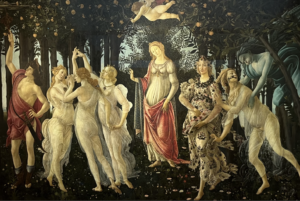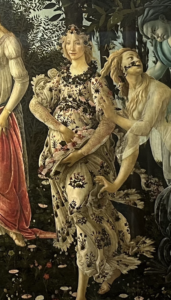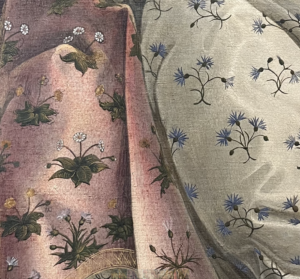Botticelli and Painted Garments in The Birth of Venus and La Primavera
by Anna Ryan Radigan
 Botticelli, La primavera (1477, Uffizi Museum, Florence)
Botticelli, La primavera (1477, Uffizi Museum, Florence) Botticelli, The Birth of Venus (1485, Uffizi Museum, Florence)
Botticelli, The Birth of Venus (1485, Uffizi Museum, Florence)
During the Fashion Mosaic to Florence, another student and I took a trip to the Uffizi on March 14th to experience some famous artworks we had never seen before. On our excursion, we came across works such as the Laocoön and his Sons replication by Baccio Bandinelli, Medusa by Caravaggio and many of Botticelli’s paintings. Two of Botticelli’s pieces we experienced were La Primavera and The Birth of Venus, using the same style of painting and representing female figures. Both the other student and I had the intention to visit the museum to look at these works with a fashion lens so, seeing these two paintings in person for the first time changed my perception of them. Immediately I looked at what these figures were wearing, what details were on it, and how it was draped over them to emphasize their figures.

So, what are they wearing? I recall studying Botticelli’s painted clothing in one of my Art History classes at Dickinson. I remember learning that although it is difficult to identify exactly what fabrics they are wearing, it is fair to say Alessandro Botticelli used his artistic license to represent these figures in their clothing. This is something Botticelli had done throughout many of his portraits of women specifically. Starting with Botticelli’s Portrait of a Young Woman from 1485 in the Pitti Palace, he paints a woman’s side profile looking out of a window. She wears a dusty-red dress with off-white details, a simple black necklace and she has her hair up in a white bound. Because the woman is not wearing heavy pearls or highly detailed dress, like many of his other portraits, we can assume that she is works in the house. Her hair up and she is settled in a home-like environment. But we should not jump straight to conclusions about her wealth. First of all, we should note that despite her unornamented garments, her status is upper class since it would have taken money to commission a portrait like this one by Botticelli. Secondly, her clothing represents her modest wealth. Although her dress has very little detail, Botticelli paints the fabric with thickness and luxury. The detail of her pleated skirt shows how hefty the dress is and how it is made up of lots of fabric. The poofs in her sleeve and the pleats represent this modest abundance of money she has put into the finer aspects of her dress. This can be just one example of Botticelli’s painting style and how he represents important figures.
Thinking about this concept in terms of his works The Birth of Venus and La Primavera, Botticelli uses floral symbols and ornamentation on the fabrics he paints to represent the figures. In both paintings, Botticelli paints a Nymph of Horas or Horas herself, the personification of Spring in Roman mythology. They both wear a white dress with a repeating pattern of bundles of flowers. While walking through the gallery, I had briefly heard that these flowers were cornflowers, a symbol of femininity and pregnancy. The dress itself symbolizes her personification as Springtime
 and additionally emphasizes her pregnant belly. The cut of the dress is poofy and it bands at the waist below her chest, where her bump is. The flowers and vines around her frame her belly and emphasize the transformation into springtime. Similar to Botticelli’s other portrait of the upper-class woman in the household, the fabrics are folded thickly, showing the rich fabric making up the garments. So, not only is her personification emphasized by the symbols on her dress, but the thickness and framing of the painted garment around the figures’ bodies highlights her pregnancy.
and additionally emphasizes her pregnant belly. The cut of the dress is poofy and it bands at the waist below her chest, where her bump is. The flowers and vines around her frame her belly and emphasize the transformation into springtime. Similar to Botticelli’s other portrait of the upper-class woman in the household, the fabrics are folded thickly, showing the rich fabric making up the garments. So, not only is her personification emphasized by the symbols on her dress, but the thickness and framing of the painted garment around the figures’ bodies highlights her pregnancy.
Botticelli is a master of painting clothing that delivers a message about the figure who wears them. Although I had studied these works before throughout Art History classes, it took me the Fashion Mosaic to actually see how the painted garments shaped the subject’s bodies and revealed their character in greater depth. It is still a mystery to me what these textiles and motifs are and where they come from. Botticelli had been from Florence in the 15th century during the Renaissance, which leaves many questions about where his sources of inspiration came from when he had painted these fabrics.